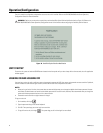
16 C4675M (2/11)
CONNECTING ANALOG CAMERAS
DX4708/DX4808 units support up to eight analog cameras and two IP cameras. DX4716/DX4816 units support up to sixteen analog and two IP
cameras. Be sure to disconnect power from each camera before connecting it to the unit. Also, use 75-ohm video coaxial cables with BNC
connectors to connect the analog cameras to the unit. Refer to Table A for coaxial cable requirements.
NOTE: Operational issues may occur when analog cameras are not correctly terminated. When connecting camera devices, use a normal
termination of 75 ohms. When using the video loop-through option, make sure the signal is terminated at the last device. For additional
information about terminating a specific device, refer to the device’s installation manual.
CONNECTING IP CAMERAS
The DX4700/DX4800 supports up to two IP cameras. For information about the supported IP camera resolutions, refer to Appendix D: Supported
IP Camera Resolutions in the DX4700/DX4800 Series Server Operation/Configuration manual.
NOTES:
• The unit does not support alarm or motion recording for IP cameras.
• IP cameras only record in the normal recording mode.
• The IP camera video stream must be configured as recommended by Pelco (refer to Figure 6).
Figure 6. Recommended IP Camera Settings
Table A. Video Coaxial Cable Requirements
Cable Type* Maximum Distance
RG59/U 229 m (750 ft)
RG6/U 305 m (1,000 ft)
RG11/U 457 m (1,500 ft)
*Cable requirements:
75-ohms impedance
All-copper center conductor
All-copper braided shield with 95% braid coverage.


















